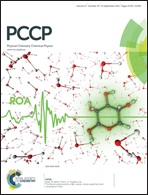Atomistic modeling of a KRT35/KRT85 keratin dimer: folding in aqueous solution and unfolding under tensile load
Abstract
We present an atomistic model of a full KRT35/KRT85 dimer, a fundamental building block of human hair. For both monomers initial structures were generated using empirical tools based on homology considerations, followed by the formulation of a naiïve dimer model from docking the monomers in vacuum. Relaxation in aqueous solution was then explored from molecular dynamics simulation. Driven by hydrophobic segregation and protein–protein hydrogen bonding relaxation dynamics result in a folded dimer arrangement which shows a striking encounter of cystein groups. Our simulations hence suggests that (i) cystein groups in the coil regions of keratin are well suited to establish disulfide bonds between the two monomers that constitute the dimer, and (ii) the particularly large number of cystein groups in the head and tail regions promotes the connection of dimers to establish meso- to macroscale fibers. Moreover, we show the molecular mechanisms of elastic and plastic deformation under tensile load. Upon elongation beyond the elastic regime, unfolding was identified as the exposure of hydrophobic moieties and the breaking of protein–protein hydrogen bonds. Therein, the step-wise character of the series of unfolding events leads to a broad regime of constant force in response to further elongation.


 Please wait while we load your content...
Please wait while we load your content...